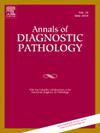Analysis of clinicopathological and immunohistochemical features of pheochromocytoma/paraganglioma
IF 1.4
4区 医学
Q3 PATHOLOGY
引用次数: 0
Abstract
This study aimed to analyze the expression of three immune markers, succinate dehydrogenase (SDHB), S-100, and alpha thalassemia retardation syndrome X-linked (ATRX), in pheochromocytoma and paraganglioma (PPGL) tumor tissues and to evaluate their correlation with histopathological parameters to predict the recurrence risk in PPGLs. A retrospective analysis was conducted using a cohort of 173 patients with PPGLs with definite pathological diagnoses and complete follow-up data. The expression of SDHB, S-100, and ATRX in the tumor tissues was detected using the EnVision immunohistochemical method. Histological grading of PPGLs was performed using the Compound Adrenal Pheochromocytoma and Paraganglioma Grading System (COPPS), and the correlation between the expression of the three immune markers and metastasis or recurrence of PPGLs was analyzed. Among 173 patients with PPGLs, 57 (32.9 %) had metastasis or recurrence. Of these 57 patients, 57.9 % (33/57) had tumors in the retroperitoneum. In 83 % (53/57) of the cases, the maximum diameter of the tumors was ≥5 cm. Vascular invasion was observed in 46 patients (80.7 %). SDHB, ATRX, and S-100 were negatively stained in 33 (57.9 %), 40(70.2 %), and 43(75.4 %) PPGL patients with metastasis or recurrence, respectively, which was significantly higher than that in those without metastasis or recurrence. These differences were statistically significant (P < 0.001). Multivariate analysis showed that tumor diameter ≥ 5 cm, negative ATRX and SDHB expressions, and vascular invasion were independent risk factors for tumor metastasis and recurrence. SDHB, ATRX and S-100 can be used as immunohistochemical indicators to predict the metastatic risk of PPGLs.
嗜铬细胞瘤/副神经节瘤的临床病理及免疫组织化学特征分析
本研究旨在分析三种免疫标志物琥珀酸脱氢酶(SDHB)、S-100和α -地中海贫血迟缓综合征x连锁(ATRX)在嗜铬细胞瘤和副节瘤(PPGL)肿瘤组织中的表达,并评估其与组织病理学参数的相关性,以预测PPGL复发风险。对173例病理诊断明确、随访资料完整的PPGLs患者进行回顾性分析。采用EnVision免疫组化方法检测肿瘤组织中SDHB、S-100、ATRX的表达。采用复方肾上腺嗜铬细胞瘤和副神经节瘤分级系统(COPPS)对PPGLs进行组织学分级,并分析3种免疫标志物的表达与PPGLs转移或复发的相关性。173例PPGLs患者中,57例(32.9%)发生转移或复发。在这57例患者中,57.9%(33/57)的肿瘤位于腹膜后。83%(53/57)的病例肿瘤最大直径≥5cm。血管侵犯46例(80.7%)。在转移或复发的PPGL患者中,SDHB、ATRX和S-100分别阴性33例(57.9%)、40例(70.2%)和43例(75.4%),显著高于无转移或复发的患者。这些差异具有统计学意义(P <;0.001)。多因素分析显示,肿瘤直径≥5 cm、ATRX和SDHB阴性表达、血管侵犯是肿瘤转移和复发的独立危险因素。SDHB、ATRX、S-100可作为预测ppgl转移风险的免疫组化指标。
本文章由计算机程序翻译,如有差异,请以英文原文为准。
求助全文
约1分钟内获得全文
求助全文
来源期刊
CiteScore
3.90
自引率
5.00%
发文量
149
审稿时长
26 days
期刊介绍:
A peer-reviewed journal devoted to the publication of articles dealing with traditional morphologic studies using standard diagnostic techniques and stressing clinicopathological correlations and scientific observation of relevance to the daily practice of pathology. Special features include pathologic-radiologic correlations and pathologic-cytologic correlations.

 求助内容:
求助内容: 应助结果提醒方式:
应助结果提醒方式:


